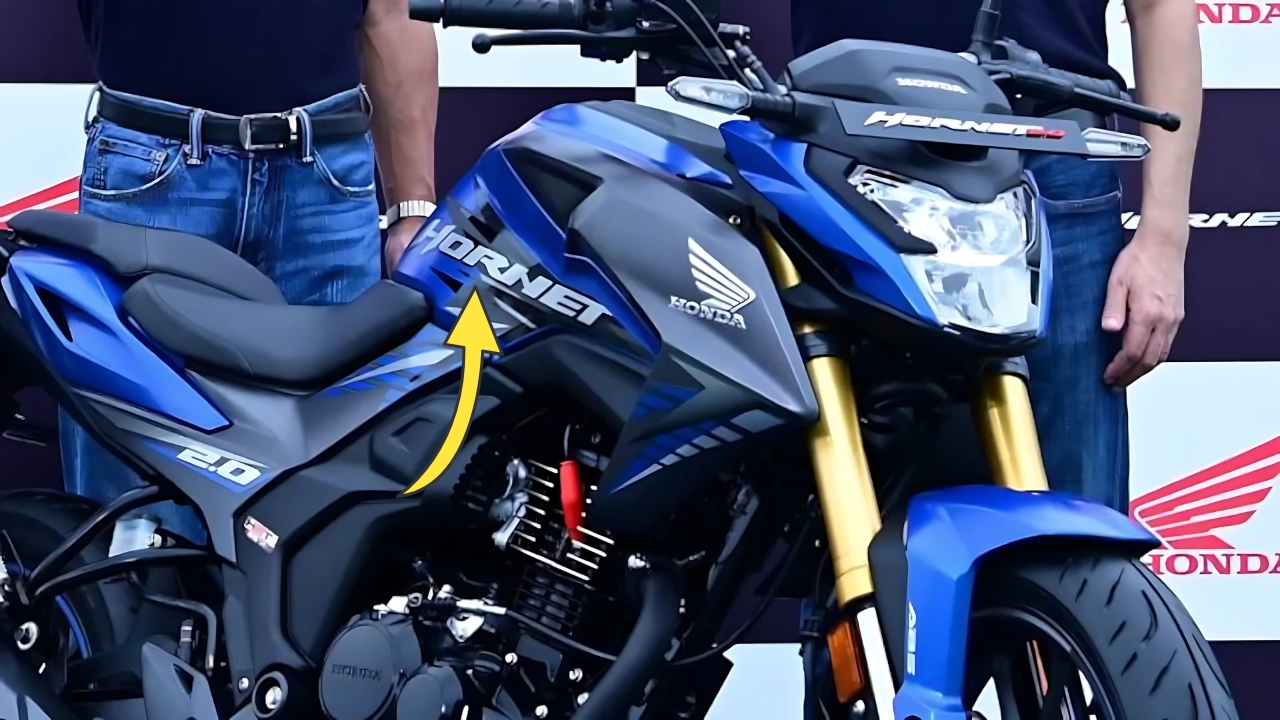Honda Hornet 2.0: In the competitive landscape of India’s two-wheeler market, Honda has consistently demonstrated its ability to create machines that combine performance, reliability, and style.
The Honda Hornet 2.0, introduced as a significant upgrade to its predecessor, represents the Japanese manufacturer’s commitment to delivering an engaging riding experience in the naked sport segment while incorporating modern design elements and technology.
This article explores what makes the Hornet 2.0 a compelling option for enthusiasts and commuters alike.
Design Evolution: Breaking the Mold
The Hornet 2.0 immediately stands out with its aggressive, forward-leaning stance that communicates its sporting intentions.
Honda’s designers have crafted a machine that looks substantially more premium than its price point suggests. The X-shaped LED tail lamp creates a distinctive signature, while the sharp tank extensions and minimal body panels contribute to its muscular appearance.
Unlike many competitors that rely on busy graphics and excessive plastic cladding, the Hornet 2.0 embraces a cleaner aesthetic with strategically placed golden accents on the black frame highlighting its structural elements.
The split-seat design and upswept exhaust further emphasize its performance-oriented character without appearing excessive or theatrical.
The gold-finished upside-down front forks—unusual in this segment—not only enhance handling capabilities but also serve as a visual centerpiece that differentiates the motorcycle from its peers.
This thoughtful integration of functional components into the design language results in a machine that appears purposeful rather than merely styled.
Heart of the Matter: Engine Performance
Powering the Hornet 2.0 is a 184.4cc, single-cylinder, air-cooled engine producing 17.26 horsepower at 8,500 rpm and 16.1 Nm of torque at 6,000 rpm.
While these figures may seem modest compared to larger displacement alternatives, Honda has tuned this powerplant to deliver its performance in a way that suits real-world riding conditions.
The engine’s character reveals itself through a responsive throttle and a smooth power delivery that builds progressively through the rev range.
Unlike some competitors that focus solely on peak numbers, the Hornet prioritizes usable performance with a healthy mid-range that proves invaluable when navigating urban traffic or enjoying twisty roads.
The five-speed transmission offers precise shifts with well-spaced ratios that complement the engine’s power delivery characteristics.
A particular highlight is the engine refinement—vibrations are kept to a minimum even at higher revs, demonstrating Honda’s engineering prowess even in their smaller displacement offerings.
For daily commuters, the fuel efficiency ranging between 40-45 kilometers per liter strikes a reasonable balance between performance and practicality, while the 12-liter fuel tank provides adequate range for both city riding and occasional weekend getaways.
Chassis and Handling: Urban Agility Meets Highway Stability
The Hornet 2.0’s handling characteristics stem from its thoughtfully designed diamond-type frame, which balances rigidity with appropriate flex.
With a kerb weight of 142 kg, the motorcycle feels nimble and responsive without sacrificing stability—an essential characteristic for a machine that will spend much of its life navigating congested urban environments.
The aforementioned upside-down front forks with 37mm diameter tubes offer 110mm of travel, providing superior front-end feel compared to conventional telescopic units typically found in this segment.
This is complemented by a mono-shock rear suspension with 5-step preload adjustability, allowing riders to tailor the setup according to their weight and riding style.
Braking duties are handled by a 276mm petal disc up front with a single-channel ABS system, while the rear employs a 220mm disc. This setup delivers confidence-inspiring stopping power with good modulation, though some riders might prefer the additional safety net of dual-channel ABS, especially when riding in wet conditions.
The 17-inch wheels at both ends are shod with relatively wide rubber—110/70 front and 140/70 rear—providing a substantial contact patch that enhances both cornering confidence and straight-line stability.
The Hornet’s 167mm ground clearance also ensures that speed breakers and uneven roads are negotiated without drama, addressing a practical concern for Indian road conditions.
Technology Integration: Modern Touches
Honda has equipped the Hornet 2.0 with a fully-digital negative LCD instrument cluster that provides essential information in a legible format, even under direct sunlight. The blue backlight adds a premium touch while enhancing visibility during night riding.
Beyond basic readouts like speed, tachometer, and fuel level, the display includes a gear position indicator and service due reminder—features once reserved for more expensive motorcycles.
The all-LED lighting system not only contributes to the modern aesthetic but also provides superior illumination compared to conventional bulbs.
The LED headlight with its distinct signature enhances visibility while the X-shaped tail lamp ensures the motorcycle remains recognizable even from a distance.
Honda’s engine start-stop switch integrates the ignition function, eliminating the need for a separate key slot and adding a layer of convenience that riders quickly come to appreciate.
These thoughtful touches demonstrate Honda’s attention to everyday usability beyond the performance metrics.
Living with the Hornet 2.0: Practical Considerations
While the Hornet 2.0’s sporting intentions are evident in its design and engineering, Honda hasn’t compromised on practicality.
The rider’s triangle—the relationship between the handlebar, seat, and footpegs—strikes a balance between sportiness and comfort, allowing for an engaged riding position without causing undue strain during longer journeys.
The 795mm seat height makes the motorcycle accessible to riders of various statures, while the well-padded seat provides reasonable comfort for both rider and pillion. Storage space is naturally limited, though the under-seat compartment can accommodate essential documents and small items.
Maintenance costs remain reasonable thanks to Honda’s widespread service network and the relatively simple nature of the air-cooled engine.
Service intervals of 6,000 kilometers for major maintenance align with industry standards, while the overall reliability inherent to Honda motorcycles means fewer unexpected workshop visits.
Market Positioning and Value Proposition
The Hornet 2.0 occupies an interesting position in Honda’s lineup, slotting between the more commuter-focused CB Unicorn and the performance-oriented CB200X.
This positioning allows it to appeal to riders seeking an upgrade from 150cc motorcycles without stepping into the more demanding realm of larger displacement machines.
When compared to direct competitors like the TVS Apache RTR 200 4V and Bajaj Pulsar NS200, the Hornet 2.0 differentiates itself through its refined engine characteristics, premium components like the USD forks, and Honda’s reputation for reliability.
While it may not lead the segment in outright performance metrics, the cohesive package offers a compelling balance that many riders will appreciate.
Honda Hornet 2.0 The Sum of Its Parts
The Honda Hornet 2.0 represents a thoughtful evolution in the naked sport segment, combining engaging performance with everyday practicality.
Rather than chasing headline-grabbing specifications, Honda has focused on creating a well-rounded motorcycle that excels in real-world conditions.
From its distinctive design and quality components to its refined engine and balanced handling, the Hornet 2.0 embodies Honda’s philosophy of engineering excellence without unnecessary com
For riders seeking a motorcycle that can transform the daily commute into an enjoyable experience while remaining capable of weekend adventures, the Hornet 2.0 makes a compelling case as a versatile companion for the discerning enthusiast.

